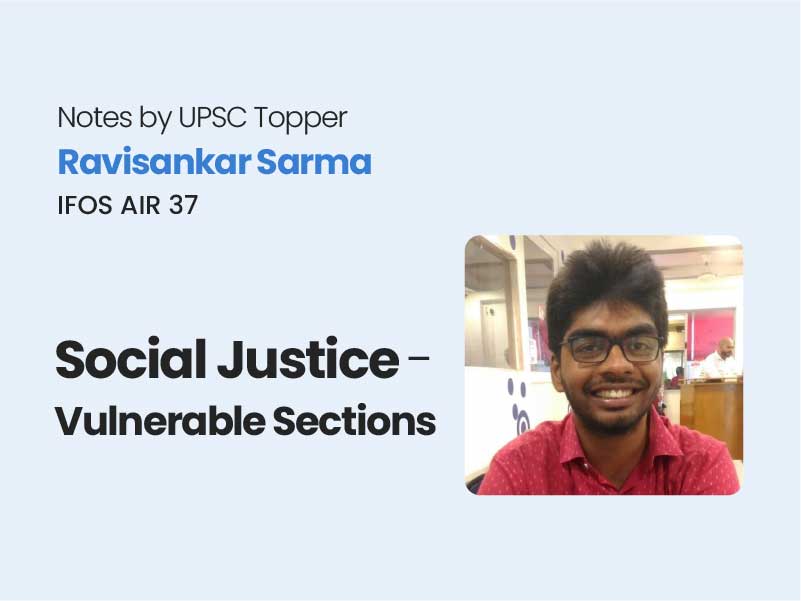Companion@360 → 7 Month programme to sharpen your writing skills → REGISTER NOW

Social Justice- Vulnerable Sections
Poverty
Absolute poverty in India has reduced from 50 percent in 1993-94 to below 5 percent in present day according to the Tendulkar poverty line of 1.91$ purchasing power parity. Poverty lines in India and all over the world by WEF and WB have been monetized on the basis of cost of basic amenities which have been increasingly diversified to include calories, nutrients, proteins, health, education, electricity, transportation, drinking water and sanitation.
Poverty Detection
Increasing Diversification of Requirements: The Tendulkar and Rangarjan committees have widened the amenities for requirement. The purchasing power required for this aggregate consumption basket has been fixed as poverty line.
Unit of Analysis: The Tendulkar and Rangarajan lines follow different units as the basis for poverty identification- individual and households respectively
Automatic Exclusion and Inclusion: The Socio-Economic caste census has brought in parameters that automatically exclude (tax payer) and include (manual scavenger) citizens into beneficiary list
Rural- Urban Divide: Indian poverty line indicators are reflective of the rural urban divide in terms of varying consumption patterns and the skewed access to amenities like drinking water, electricity and sanitation where rural areas appear highly disadvantaged. The falling agricultural incomes have further eroded their financial capability.
Reasons for Poverty
Overpopulation: Being the 2nd most populous country in the world, India has great strain on natural resources of land and water which deprives a select few on the basis of financial capability
Loss of Agriculture Income: Fragmentation of lands, climate changes and declining fertility of soil has led to declining incomes of farmers causing a downward spiral in rural economy
Lack of livelihood opportunities: India has a huge demographic potential that may become a liability unless sufficient opportunities are created for them with regard to employment and entrepreneurship
Coverage of secondary and higher education (Accessibility and Affordability issues)
Highest out of pocket expenditure in Health: A lack of a comprehensive health insurance policy and poor public sector healthcare has caused a highly vulnerable urban and rural population deprived of sanitation and hygiene to spend big on the treatment of diseases
Solutions Needed
Targeted Welfare Approach: The government can focus on targeted areas of backward regions in states of U.P, Bihar and Madhya Pradesh. Greater impetus can be given to skill development initiatives and entrepreneurship opportunities to leverage demographic asset of theses regions
Participative Development: The government can curb direct financial assistance and instead seek to create livelihood opportunities for the deprived to make them self-reliant. SHG platforms and MGNREGA can serve the same purpose
Universal Provision of Social Services: Public expenditure must be drastically increased and public partnerships sought to plug infrastructural gaps in rural and remote regions of the country in health and education sector. A universal health insurance under the U.K model should be ushered in to reduce the out of pocket expenditure for healthcare
Diversification of welfare provisions: The government’s welfare provisions may be diversified in accordance with widening purview of poverty. The nutrition basket of PDS and mid-day meal schemes can be diversified to accommodate proteins and micro-nutrients for the population
Plugging leakges: The Aadhaar based DBT can be used to directly transfer subsidies to the deserving t increase transparency and plug leakage of funds in welfare endeavours of the government
Eg: Wages of MGNREGA
In the future, the government may explore the provision for provision of UBI through this platform.
CSR Programmes
Issues
- Diversion of funds
- Green Washing
- Emancipating own employees
- Regional and Sectoral Imbalance
Way Forward
The government has launched the National CSR data portal which contains all filed information with respect to expenditure across states, districts and developmental sectors. This can help in evaluating effectiveness of CSR projects and consolidating CSR activities.
Increased transparency in financial and non-financial information also keeps a check on fund diversion thereby increasing accountability on companies to spend productively.
Read All Notes by UPSC Topper Ravisankar Sarma

